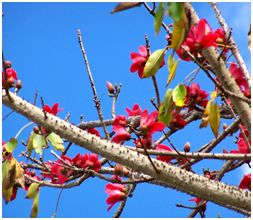
Botanica Name - Bombax ceiba L.
Common Name – Semal
Classification –
Kingdom – plantae
Division – Magnoliophyta
Class – Magnoliopsida
Order – Malvales
Family – Malvaceae
Genus – Bombax
Species – ceiba
Characteristics Of Family Malvaceae
This is also called Mallow family .Stellate hairs on the young parts, mucilaginous juice present, leaves alternate, stipulate, multicostate reticulate; inflorescence solitary or cyme; flower actinomorphic, hermaphrodite, hypogynous, pentamerous, with epicalyx, calyx free or united, corolla free; stamens indefinite, monadelphous; anthers monothecous, stamens united to form a tube; gynoecium many often five, syncarpous, ovary multilocular, superior, axile placentation; fruit schizocarpic carcerulus or capsule.
Habitat - Moist deciduous and semi-evergreen forests also in the plains . ccasionally found in plains from the coast ,on the deciduous belt of the hills to 1400m.
Distribution – India , Assam , Bihar , Kerala , Madhya Pradesh , Maharastra , Odisha .
Status – Least concern
Plant description –
Habit 10-30m tall, perennial, large-sized, deciduous tree.Stem Woody, solid, erect, columnar trunk, grey, glabrous bark with hard conical black prickles, delicate branches cylindrical, glabrous, smooth with distinct nodes and internodes.
Leaves Compound, digitate, leaflets 2-7, dorsiventral, entire, unicostate reticulate venation, oval or lanceolate, acute at the base, with a sharp point at the apex, petiolate, stipulate, alternate, pentastichous.
Inflorescence solitary or cluster of several extra-axillary flowers. Flower solitary, paired or clustered; blood red. Fruit an oblong, 4-5" long, loculicidal capsule.Seeds Gglabrous, with wooly fibrous outgrowths of silky hairs.
Uses
The flowers are astringent and refrigerant. They are used to treat cutaneous troubles.
The young roots are diuretic and tonic. They are used in the treatment of cholera, tubercular fistula, coughs, urinary complaints, nocturnal pollution, abdominal pain due to dysentery, and impotency.
The gum is astringent, demulcent and tonic It is used in the treatment of dysentery, haemoptysis in pulmonary tuberculosis, influenza and menorrhagia.
The leaves are hypotensive and hypoglycaemic. A decotion of the shoots have reputedly been used to treat ulcers of the palate, syphilis, leprosy and spider or snake bites.
An oil obtained from the seed is used to make soap and for illumination etc. It can be used as a substitute for cottonseed oil.
The fibrous bark is used for making ropes.
An extract of the flowers is used as an ingredient in commercial cosmetic preparations as a humectants